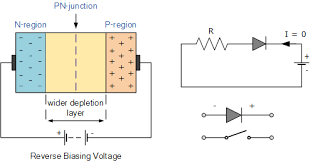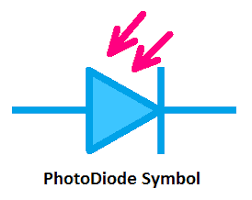A diode is a semiconductor device that consists of two terminals.
Diode
It allows electricity to flow in one direction but blocks it in the opposite direction. This behavior of the diode can be used to convert alternating current (AC) to Direct current (DC). They also find application in logic circuits.
Anode and Cathode in a Diode
The White strip at one end of the diode signifies that that end is the cathode (-) end.
Working of a Diode
The figure below is a simple circuit to show the working of a diode.
- When a positive (+) voltage is given to the anode (+) and a negative (-) voltage is given to the cathode (-), the Diode is said to be Forward biased. The diode will allow current to flow in this condition.
- When a negative (-) voltage is given to the anode (+) and a positive (+) voltage is given to the cathode (-), the Diode is said to be Reverse biased. The diode will not allow current to flow in this condition.
In the first case, we see that when a sufficient voltage is given to the diode in the forward direction, current passes through the diode. In the second case, the diode is placed in the opposite (reverse) direction. This means no current passes through the diode.
Current flow through a Diode
Real-world Diode
Ideally, diodes will block any and all current flowing the reverse direction, or just act like a short-circuit if current flow is forward. Unfortunately, actual diode behavior isn’t quite ideal. Diodes do consume some amount of power when conducting forward current, and they won’t block out all reverse current. Real-world diodes are a bit more complicated, and they all have unique characteristics which define how they actually operate.
Current-Voltage relationship
The most important diode characteristic is its current-voltage (i-v) relationship. This defines what the current running through a component is, given what voltage is measured across it. Resistors, for example, have a simple, linear i-v relationship. The i-v curve of a diode, though, is entirely non-linear.
Depending on the voltage applied across it, a diode will operate in one of three regions:
- Forward bias: When the voltage across the diode is positive the diode is “on” and current can run through. The voltage should be greater than the forward voltage (VF) in order for the current to be anything significant.
- Reverse bias: This is the “off” mode of the diode, where the voltage is less than VF but greater than -VBR. In this mode current flow is (mostly) blocked, and the diode is off. A very small amount of current (on the order of nA) – called reverse saturation current – is able to flow in reverse through the diode.
- Breakdown: When the voltage applied across the diode is very large and negative, lots of current will be able to flow in the reverse direction, from cathode to anode.
Types of Diodes
Normal Diodes
Standard signal diodes are among the most basic, average, no-frills members of the diode family. They usually have a medium-high forward voltage drop and a low maximum current rating. A common example of a signal diode is the 1N1484. Very general purpose, it’s got a typical forward voltage drop of 0.72V and a 300mA maximum forward current rating.
A rectifier or power diode is a standard diode with a much higher maximum current rating. This higher current rating usually comes at the cost of a larger forward voltage. The 1N4001, for example, has a current rating of 1A and a forward voltage of 1.1V.
Light-Emitting Diodes (LED)
The flashiest member of the diode family must be the light-emitting diode. These diodes quite literally light up when a positive voltage is applied. Like normal diodes, LEDs only allow current through one direction. They also have a forward voltage rating, which is the voltage required for them to light up. The VF rating of an LED is usually larger than that of a normal diode (1.2~3V), and it depends on the color the LED emits. For example, the rated forward voltage of a Super Bright Blue LED is around 3.3V, while that of the equal size Super Bright Red LED is only 2.2V. The details of LEDs are discussed in the next section.
Schottky Diodes
Another very common diode is the Schottky diode. The semiconductor composition of a Schottky diode is slightly different from a normal diode, and this results in a much smaller forward voltage drop, which is usually between 0.15V and 0.45V. They’ll still have a very large breakdown voltage though.
Schottky diodes are especially useful in limiting losses, when every last bit of voltage must be spared. They’re unique enough to get a circuit symbol of their own, with a couple bends on the end of the cathode-line.
Zener Diode
Zener diodes are the weird outcast of the diode family. They’re usually used to intentionally conduct reverse current. Zener’s are designed to have a very precise breakdown voltage, called the zener breakdown or zener voltage. When enough current runs in reverse through the zener, the voltage drop across it will hold steady at the breakdown voltage.
Taking advantage of their breakdown property, Zener diodes are often used to create a known reference voltage at exactly their Zener voltage. They can be used as a voltage regulator for small loads, but they’re not really made to regulate the voltage to circuits that will pull significant amounts of current.
Photo Diodes
Photo diodes are specially constructed diodes, which capture energy from photons of light to generate electrical current. Kind of operating as an anti-LED. Solar cells are the main benefactor of photo diode technology. But these diodes can also be used to detect light, or even communicate optically.














No comments:
Post a Comment